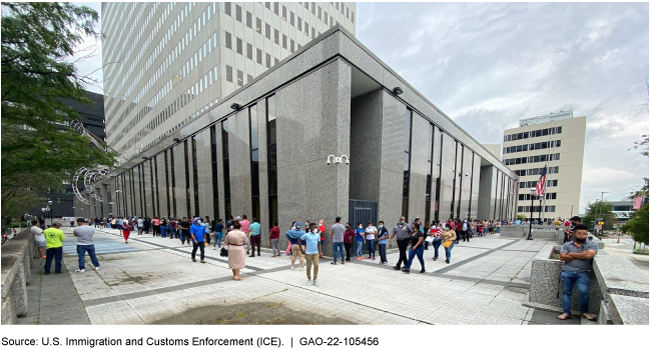Southwest Border: Challenges and Efforts Implementing New Processes for Noncitizen Families
Fast Facts
Border Patrol encountered 1.7 million noncitizens between ports of entry in FY 2021, a 300% increase over FY 2020. To help deal with this increase, Border Patrol created two processes to release families (parents and children under 18) into the U.S. without initiating immigration removal proceedings. This reduced their time in Border Patrol custody. Border Patrol told the families to report to Immigration and Customs Enforcement to start their immigration court proceedings.
As of March 1, 2022, about 75% of these family members had reported to ICE as required. ICE conducted several operations to try to locate the rest.
Public Queue Outside of an ICE Field Office in Baltimore, September 9, 2021

Highlights
What GAO Found
U.S. Border Patrol's implementation of the Notice to Report (NTR) process created challenges for U.S. Immigration and Customs Enforcement (ICE), which the agencies sought to address in developing the parole plus Alternatives to Detention (ATD) process. In March 2021, Border Patrol initiated the NTR process to reduce agents' administrative processing times by releasing noncitizen family units (parents and children under 18) without Notices to Appear. However, Border Patrol and ICE identified challenges with the NTR process. ICE officials stated they were concerned that family units were not reporting to field offices as required. Further, ICE had difficulty locating some of these individuals due to limited address information. Border Patrol released about 94,000 family unit members with an NTR before terminating this process in November 2021.
In July 2021, Border Patrol and ICE initiated a second process whereby agents release family units into the U.S. on humanitarian parole and enroll the heads of household in ICE's ATD program (or, parole plus ATD). ATD uses case management and electronic monitoring to help ensure noncitizens comply with their release conditions, allowing ICE to better track those released without a Notice to Appear. From July 2021 through February 2022, Border Patrol released about 91,000 family unit members under parole plus ATD.
ICE has efforts underway to initiate removal proceedings for family units that Border Patrol released with an NTR or under parole plus ATD. As of March 1, 2022, about three-quarters of family unit members (nearly 140,000) had reported to an ICE field office. To try to locate those who had not reported, ICE undertook several nationwide enforcement operations between November 2021 and June 2022. ICE officials stated family units that do not report, or that ICE does not locate, are to be referred for further enforcement action on a case-by-case basis to focus on the greatest threats to homeland security.
As of March 20, 2022, ICE issued Notices to Appear to about half of all family unit members (about 100,000) processed with an NTR or under parole plus ATD. According to ICE officials, ICE faces resource constraints processing those who report and issuing Notices to Appear. In July 2022, U.S. Customs and Border Protection and ICE issued a new policy under which they will share responsibility for initiating removal proceedings for those released without Notices to Appear.
Noncitizen Family Unit Members Processed with a Notice to Report (March through November 2021) and under Parole plus Alternatives to Detention (July 2021 through February 2022)

aData as of Mar. 18, 2022, for Notices to Report and Mar. 21, 2022, for parole plus Alternatives to Detention.
Why GAO Did This Study
In fiscal year 2021, Border Patrol reported about 1.7 million apprehensions of noncitizens between ports of entry—a 300 percent increase over fiscal year 2020. This included approximately 451,000 apprehensions of family unit members. Compounding this increase were continued concerns related to COVID-19 and physical distancing protocols that imposed space limitations on facilities.
To address these concerns and reduce time in custody, Border Patrol and ICE initiated two new processes in 2021, referred to as NTR and parole plus ATD. Border Patrol released family units into the U.S. without first issuing them a charging document—generally a Notice to Appear—which places them into immigration court removal proceedings. Instead, Border Patrol instructed them to report to an ICE field office. ICE officials are to further process family unit members who report to field offices, such as issuing them a Notice to Appear.
GAO was asked to review Border Patrol's and ICE's implementation of the NTR and parole plus ATD processes. This report describes (1) Border Patrol and ICE implementation of the NTR and parole plus ATD processes, and (2) ICE's efforts to initiate removal proceedings for family unit members processed with NTRs or under parole plus ATD.
GAO analyzed Border Patrol and ICE policies, guidance, and data on individuals processed with an NTR or under parole plus ATD and who reported to ICE as required. GAO also interviewed officials in Border Patrol and ICE headquarters and selected field locations.
For more information, contact Rebecca Gambler at (202) 512-8777 or GamblerR@gao.gov.
